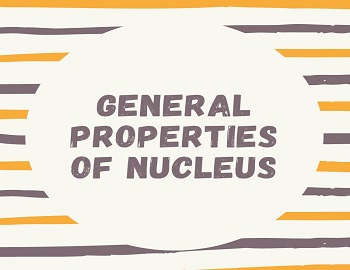General Properties of Nucleus:
(1) Atomic Number (Z)- It represents the total number of protons inside the nucleus.
(2) Mass Number (A)- It represents the total number of protons and neutrons inside the nucleus.
(3) Nuclear Mass- It is expressed in terms of atomic mass unit (amu). One amu is defined as 1/12th mass of C12 i.e. there are 6.025 x 1026 atoms in 1 kg mole (or 12 kg) of carbon.

(4) Nuclear Charge- The charge of the nucleus is positive due to protons contained in it.
| Charge of proton = 1.6 x 10-19 C |
(5) Nuclear Size- Nuclear radius is of the order of 10-15 m. According to the semi-empirical formula, the nuclear radius is given by-
| R = R0 A1/3 Where R0 is the constant with an average value of 1.4 x 10-15 m. |
(6) Nuclear Shape- In order to provide the least surface area, the nucleus is always spherical in shape.
(7) Nuclear Density-

(8) Nuclear Spin and Quantum States-Similar to electrons, nucleons also possess a spin. Also, there are sets of quantum states and a corresponding number of discrete energy levels with nucleons. Transitions between different nuclear states are accompanied by the emission of γ-rays.
(9) Nuclear Stability- Nuclear stability means that the nucleus of an element is stable and thus it does not decay spontaneously emitting any kind of radioactivity.
Factors affecting nuclear stability are-
(i) Number of Protons and Neutrons- If the N/Z ratio is one, nuclei are more stable and if N/Z > 1.5, nuclei are unstable.
Also for an even number of protons and neutrons, nuclei are in general stable than those having an odd number of them.
(ii) Binding Energy- Intermediate elements with comparatively large binding energy per nucleon are more stable than lighter and heavier elements.
(iii) Nuclear Forces- According to Yukawa Meson’s theory, nuclear forces arise due to the rapid exchange of π-mesons (π+, π0 and π–) between protons and neutrons.
Nuclear forces are short-range, attractive forces which are strongest in nature for P-P, P-N and N-N interactions. These forces are independent of charge.









Comments (No)